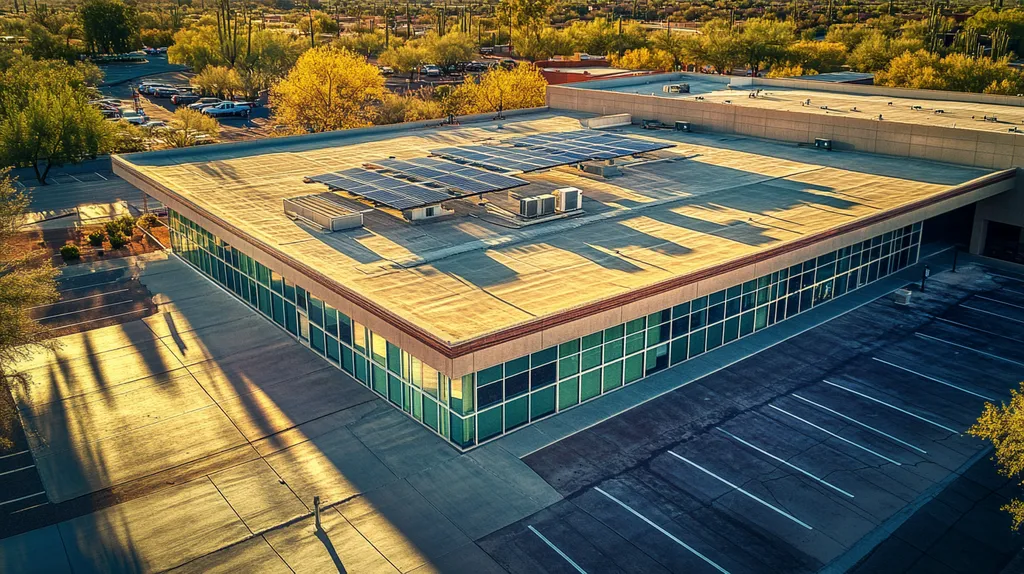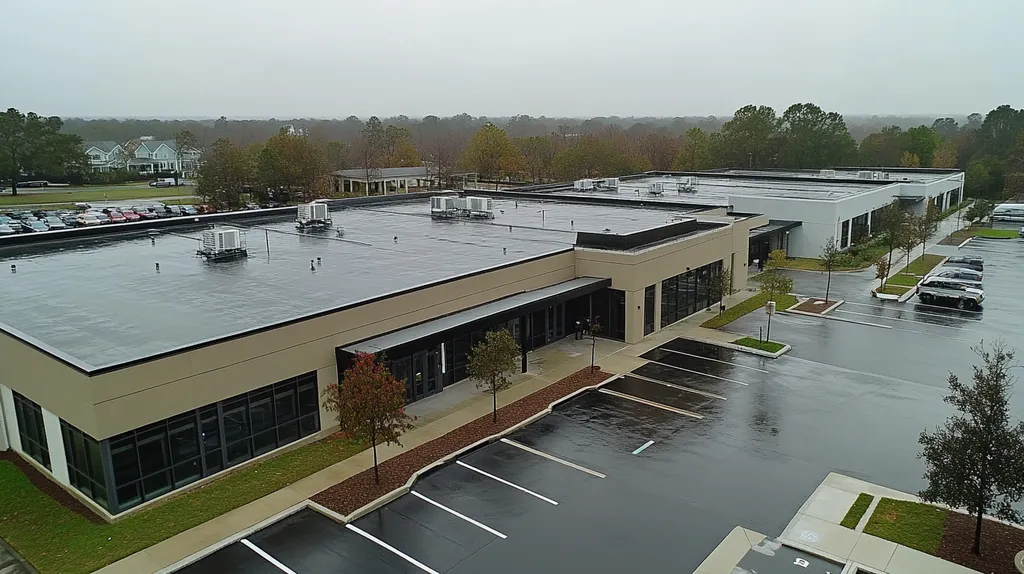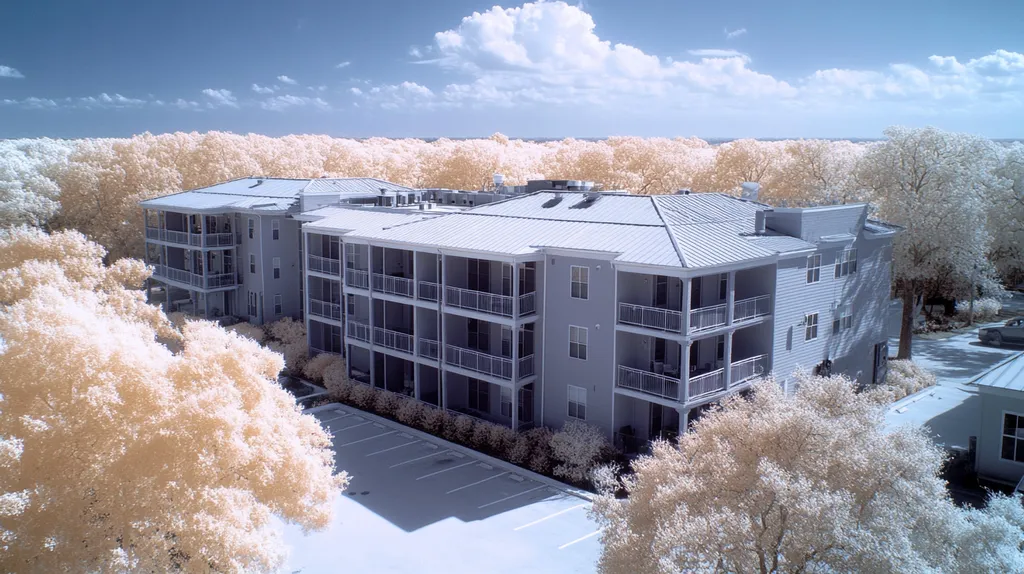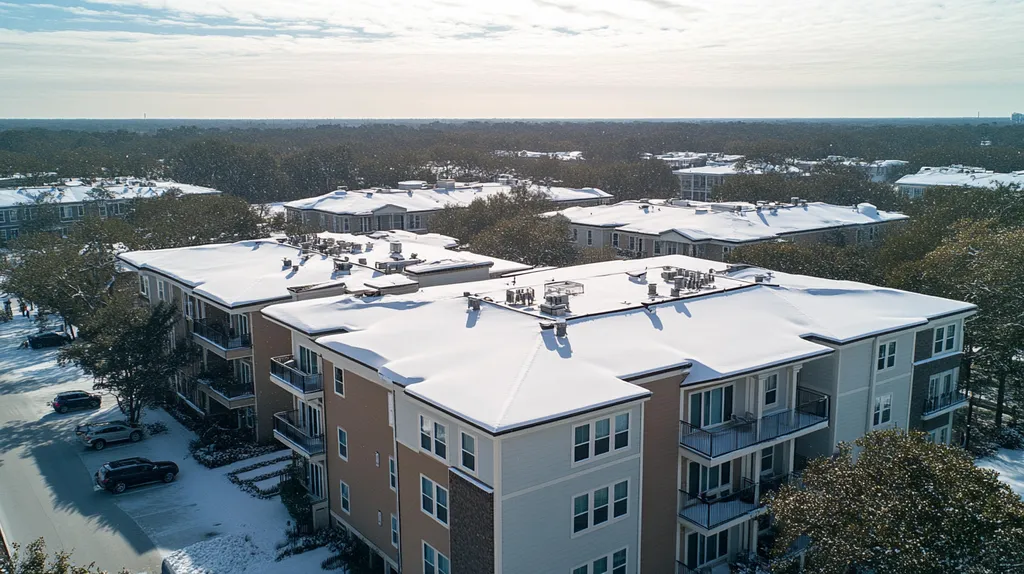Severe storms leave 40% of commercial roofs with hidden damage that can multiply repair costs tenfold if left unchecked. Despite this startling reality, many building owners continue to delay critical post-storm inspections.
The consequences of postponing these vital assessments extend far beyond immediate repair costs, threatening structural integrity, occupant safety, and insurance coverage.
This comprehensive guide separates fact from fiction regarding commercial roof inspections, equipping property owners with evidence-based strategies to protect their investments and prevent catastrophic failures.
SECTION 1: COMMON MISCONCEPTIONS
After a severe storm, the state of a commercial roof can be precariously unstable. Yet, many property owners mistakenly assume that putting off inspections won’t inflict any harm on their roofing systems. Research indicates that even a brief delay can significantly increase repair costs and cause further damage. It’s essential to debunk these common misconceptions about roof inspections, as doing so can help safeguard property value and ensure the safety of all building occupants.
Delayed Inspections Are Harmless
Some property owners believe that postponing a roof inspection is inconsequential. This dangerous misconception can lead to dire outcomes. Undetected damage often worsens over time, paving the way for leaks, mold growth, and catastrophic structural issues.
Statistics reveal that water damage from neglected roof leaks can inflate repair costs by up to 50%. This can necessitate a series of increasingly complex repairs, which a simple inspection and timely maintenance could have prevented. Early identification of potential problems is crucial, making regular inspections indispensable.
Waiting too long to inspect a roof dramatically increases the chance of escalating damage. Each rainstorm amplifies the risk, threatening to expand manageable issues into significant financial burdens. Acting swiftly after severe weather can make a world of difference, turning potential disasters into manageable repairs.
Only Visible Damage Matters
A common fallacy is that only visible damage warrants concern following a storm. Many property owners overlook the hidden vulnerabilities that can lurk beneath the roof’s surface. Minor surface issues, like small dents or cracks, may mask significant problems underlying the roof membrane.
For instance, a seemingly minor crack can permit water intrusion, which over time leads to extensive decay and costly structural failures. Research shows that around 80% of roofing issues originate from underlying problems that remain invisible to the untrained eye. Thorough inspections must include assessments for moisture trapped beneath the roof surface.
To protect their investments, property owners must understand that inspections require a comprehensive approach that goes beyond visible damage. Engaging professional inspectors equipped with the right knowledge and tools is vital for uncovering these hidden threats.
DIY Inspections Are Sufficient
Many believe they can handle post-storm roof inspections themselves, thinking it’s a way to save costs. However, employing a DIY approach often proves to be a costly error. Professional inspections utilize specialized techniques and tools that most property owners do not possess, making them invaluable.
Expert inspectors possess the necessary training to recognize subtle signs of damage and to grasp the intricacies of roofing systems. They can identify both visible and concealed issues, which DIY inspections typically overlook.
A thorough professional inspection also provides essential documentation, critical for navigating insurance claims. Without this formal report, DIY efforts may complicate the claims process, especially if hidden damage emerges later.
Choosing the DIY route can lead to catastrophic oversights that ultimately cost much more down the line. Engaging roofing experts for a comprehensive assessment is a crucial step in ensuring the building’s longevity and health.
SECTION 2: PRACTICAL IMPLICATIONS
After severe storms, the urgency of conducting thorough commercial roof inspections cannot be overstated. A staggering 30% of commercial building owners encounter significant damage due to undetected roof problems. Ignoring the necessity for immediate inspections can lead to serious safety risks, weakened structural integrity, and disruptions in daily operations. Understanding these critical implications is essential for property owners and facility managers alike.
Safety Risks and Liability
The aftermath of a storm can create considerable safety hazards for both occupants and workers. Damaged roofs may conceal hidden dangers such as sharp debris, unstable structures, or even potential collapses.
Property owners could face legal liability if an injury occurs because of unsafe conditions that should have been addressed promptly. Regular inspections help identify vulnerabilities needing immediate action, thereby minimizing the risk of accidents.
Moreover, being proactive about safety can positively influence a building’s insurance costs. Insurers often provide better premium rates to those who can demonstrate a commitment to safety through routine maintenance.
Ultimately, investing in post-storm inspections establishes a safer environment, safeguarding both people and property.
Structural Integrity and Longevity
Severe storms can jeopardize a roof’s structural integrity, often in ways that may not be immediately visible. Water infiltration, for example, can gradually degrade insulation and decking, leading to long-lasting damage.
Disregarding these problems can drastically reduce the roof’s lifespan. Delaying necessary repairs may eventually require costly complete replacements, racking up thousands of dollars in expenses.
It’s vital for property owners to grasp the long-term consequences. Addressing emerging issues swiftly after a storm can prolong the roofing system’s life and minimize future financial burden.
Maintaining the roof’s integrity also supports the overall stability of the building. A well-maintained roof helps prevent extensive damage to interior spaces, protecting the business’s assets from unexpected costs.
Impact on Building Operations
A compromised roof can significantly disrupt normal building operations, impacting everything from daily functioning to tenant satisfaction. Water leaks often lead to unsanitary conditions and decreased productivity within the workplace.
For commercial enterprises, operational downtime translates directly into lost revenue. If clients or customers encounter facilities with visible disrepair, they may choose to take their business elsewhere.
Regular post-storm inspections can avert these disruptions. Property owners who respond quickly can tackle issues before they escalate, ensuring smooth and efficient operations.
Additionally, well-maintained roofs foster a positive reputation. Buildings in good condition are more likely to attract desirable tenants and increase overall property value.
SECTION 3: COST OF MISINFORMATION
The consequences of neglecting roof inspections after severe storms can be financially devastating for commercial property owners. Studies show that the costs incurred from delayed or insufficient assessments often exceed the initial investment required for the repairs. Ignoring critical information can lead to cascading liabilities, compliance issues, and an avalanche of unexpected costs. This section delves into these urgent matters that every property owner needs to recognize.
Financial Consequences of Neglect
Overlooking post-storm roof inspections can have dire financial consequences. When damages go unassessed, they can quickly escalate, resulting in repairs that could have easily been avoided. For property owners, this could involve significant expenses related to water damage, mold remediation, and necessary structural repairs.
Take, for example, a seemingly minor roof leak caused by storm damage; it can swiftly evolve into a significant issue that jeopardizes the integrity of the entire structure. The continued neglect of such issues can spiral out of control, straining repair budgets and disrupting operational efficiency.
Moreover, unresolved roof problems can seriously affect property value. Prospective buyers or tenants often view roofing issues as major red flags, leading to decreased interest and lower offers during future transactions.
Ultimately, timely inspections can save property owners thousands of dollars, securing their investments from enduring damage and loss.
Insurance and Compliance Issues
Understanding the implications of insurance regarding storm damages is essential for property owners. Failing to conduct proper inspections may jeopardize insurance claims. Most insurance providers require documented maintenance evidence, and neglected inspections can result in denied coverage.
In some scenarios, insurers may contend that damages worsened due to delayed upkeep, possibly leading to costly litigation. Additionally, adhering to regulatory compliance is vital in many regions, which often mandates routine inspections, including after severe weather events.
Non-compliance can lead to fines and legal penalties, adding another layer of complexity to an already daunting financial landscape. Maintaining roofs—especially following storms—ensures compliance and shields property owners from potential insurance pitfalls.
Furthermore, a proactive inspection regimen can simplify the claims process, making future claims more likely to be approved and adequately covered.
Unexpected Repair and Replacement Costs
Neglecting roof inspections can quickly lead to unexpected repair and replacement costs. A minor issue, if ignored, may necessitate a complete roof replacement. For instance, a section of the roof weakened by storm debris may require extensive renovations down the line.
These unforeseen expenses can strain facility budgets and cash flow. What could have been a simple fix may evolve into a costly repair project, stretching timelines and financial resources thin.
Moreover, extended business operations interruptions during significant repairs can lead to lost revenue. Each day that a roof problem lingers adds financial pressure and operational challenges for many businesses.
In the end, the cost of ignoring roof inspections will far outweigh the investment in preventive measures. For this reason, proactive assessments are essential to maintaining a healthy and cost-effective roofing system, particularly after severe storms.
SECTION 4: REALITY CHECK
After severe storms, commercial roofs can sustain significant, often hidden damage that threatens the integrity of a building. Alarmingly, studies show that up to 80% of roof-related issues arise from undetected damage. Property owners must grasp the urgent need for thorough inspections to prevent costly repairs and safety hazards down the line. This section will underline the identification of hidden damage, the vital role of professional inspections, and the advantages of advanced inspection tools.
Identifying Hidden Damage
Hidden damage can manifest in various forms, including leaks, punctures, and flashing issues that may not be immediately visible. A roof might outwardly appear intact, even when water infiltration is quietly at play. Over time, trapped moisture can encourage mold growth and weaken the structure, posing serious health and safety risks.
Roof membranes present another danger; a small puncture could evolve into a major leak if ignored. This highlights the critical need to look beyond superficial observations, as minor damages can rapidly escalate and disrupt business operations.
Property owners should remain vigilant for symptoms that signal potential issues, such as water stains or blistering. These indicators often reflect deeper issues that demand prompt attention. Early identification can result in significant cost savings later on.
Routine monitoring and proactive evaluations for unusual signs can enhance the safety and longevity of the roof. Every unaddressed issue is like a ticking time bomb waiting to trigger future expenses and complications.
Importance of Professional Inspections
After severe storms, professional inspections become indispensable. Experts are trained to identify issues that property owners might overlook, such as compromised structural elements or hidden water damage. Their keen evaluations can assess the full extent of damage and prioritize necessary repairs.
Engaging a roofing professional ensures that inspections are conducted following best practices and safety protocols. These specialists employ comprehensive methods and produce detailed reports, outlining required repairs and maintenance strategies.
Delays in hiring professionals can lead to unchecked damage escalation. Unresolved issues complicate insurance claims, potentially leaving property owners to bear the financial burdens themselves.
Investing in regular expert assessments translates to long-term savings and peace of mind. These inspections play a crucial role in preserving a roof’s integrity while contributing to its lifespan.
Role of Advanced Inspection Tools
Advanced inspection tools transform the roof assessment process, enabling greater accuracy and efficiency. Drones equipped with high-resolution cameras can reveal vulnerabilities from perspectives that traditional methods may miss, providing an immediate aerial overview without endangering workers’ safety.
Thermal imaging cameras offer valuable insights by identifying temperature fluctuations that suggest moisture accumulation. This technology allows professionals to detect hidden leaks before they escalate into more serious problems.
Data analytics tools improve the interpretation of inspection findings, enabling informed decision-making about repairs and maintenance. By utilizing these advanced technologies, property owners can tackle concerns promptly and effectively.
Ultimately, adopting these modern inspection capabilities enhances safety, promotes cost-efficiency, and extends the lifespan of commercial roofs, ensuring properties remain secure and reliable.
SECTION 5: EVIDENCE-BASED ALTERNATIVES
After severe storms, commercial roofs face significant challenges that demand urgent intervention. Neglecting thorough inspections can leave hidden damage unchecked, resulting in unexpected and costly repairs. Alarmingly, nearly 40% of commercial roofing failures arise from inadequate maintenance. To protect investments and ensure roof longevity, property owners must adopt effective strategies. This section outlines the value of comprehensive inspection checklists, regular maintenance programs, and the advantages of timely repairs.
Comprehensive Inspection Checklists
Implementing comprehensive inspection checklists can elevate the effectiveness of roof evaluations. These structured guides ensure important areas, like flashing, drainage systems, and seams, are systematically reviewed, reducing the risk of overlooked problems.
Moreover, these checklists enhance communication between roofing professionals and property owners, providing documented evidence of roof condition and maintenance history. Such records prove invaluable when navigating insurance claims or planning necessary repairs.
Adopting digital checklists further streamlines the inspection process. With modern technology, property managers can access real-time updates and historical maintenance data. This capability not only improves efficiency but empowers managers to make informed decisions quickly.
Incorporating a thorough checklist into routine evaluations can significantly enhance a commercial roof’s long-term performance, ensuring that critical problems are addressed before they grow into larger, costlier issues.
Regular Maintenance Programs
Establishing regular maintenance programs is instrumental in extending a roof’s lifespan. These initiatives often encompass scheduled inspections, cleaning, and tailored preventive measures specific to the roof type, helping to catch wear and tear early.
Significantly, studies reveal that proactive maintenance can increase a roof’s lifespan by up to 25%. This commitment not only protects the investment but also minimizes disruptions to business operations. By prioritizing regular upkeep, property owners can preserve structural integrity and avoid the financial burden of emergency repairs.
Additionally, advances in technology and roofing materials allow maintenance practices to evolve. Staying informed about the latest developments ensures that property managers can implement the best strategies for their roofs.
Creating a custom maintenance schedule tailored to the building’s specific needs greatly enhances roof reliability, ensuring that no aspect remains unchecked for too long.
Benefits of Timely Repairs
Promptly addressing roof issues is crucial to maintaining the overall health of a building. Timely repairs can prevent minor issues from escalating into major headaches. For instance, overlooking a small leak can lead to mold growth, posing health risks and harming property value.
Furthermore, swift repairs bolster energy efficiency. A well-maintained roof facilitates proper insulation and ventilation, which can significantly cut heating and cooling costs for building owners over time.
Investing in timely repairs also enhances property value. A roof in optimal condition is more attractive to prospective buyers or tenants, signaling that the property is well-managed and cared for.
In summary, prioritizing timely interventions fosters a safer and more cost-effective environment for occupants. By addressing repairs as soon as issues arise, property owners protect their investments and enhance operational efficiency.
SECTION 6: TEST AND VERIFY
In the aftermath of severe storms, accurately assessing roof damage is not just important—it’s essential. Many property owners underestimate the risks of undetected damage, which can lead to costly repairs and enduring structural issues. Alarmingly, nearly 40% of roofing failures stem from damage that remains hidden for months. Utilizing advanced assessment techniques like infrared scans and core sampling empowers property managers to ensure their roofs are secure and functional after severe weather events.
Using Infrared Scans and Core Samples
Infrared scans provide a powerful, non-invasive method for detecting moisture beneath roof membranes. This technology leverages heat detection to uncover hidden water damage that standard visual inspections often miss. By capturing temperature variations, infrared scans can identify areas of concern that require immediate intervention.
Core samples serve as an additional validation tool. By extracting a small portion of the roofing material, inspectors can closely examine the layers and gauge their integrity. This method reveals the extent of any water penetration and gives insight into the overall performance of the roofing system.
When combined, these techniques provide property owners with a thorough understanding of their roofs’ conditions. They enable proactive measures that reduce the risk of severe damage, ultimately protecting financial investments. Furthermore, these advanced methods enhance the safety and structural reliability of the building.
Scheduling regular inspections that integrate these technologies is highly advisable. Not only do they offer peace of mind, but they also aid in planning future roofing expenditures based on precise assessments.
Documenting Inspection Results
Accurate documentation is vital for tracking a roof’s condition over time. Comprehensive reports from inspections that include photographs and detailed findings become essential records. These documents can facilitate insurance claims and assist in future maintenance planning.
Every inspection should culminate in a thorough report listing all identified damages, recommended repairs, and maintenance actions. Consistent and meticulous documentation helps property owners monitor their roofs’ performance more effectively, allowing for better budgeting and forecasting of repairs.
Moreover, well-documented inspection results build trust between property owners and roofing contractors. These records serve as a foundation for discussions on warranties and compliance issues, ensuring all parties agree on the necessary actions moving forward.
Implementing a robust documentation approach also aids in meeting compliance regulations, which are increasingly significant. Having inspection outcomes readily available can prove invaluable during audits or regulatory evaluations.
Compliance and Regulatory Requirements
Commercial roofs must adhere to specific compliance and regulatory standards set forth by local and national codes. Failing to meet these requirements can lead to costly penalties and delays in insurance claims. Property owners should keep abreast of regulations concerning maintenance and inspections to mitigate potential risks.
Compliance ensures roofing systems maintain safety and reliability, providing protection for all occupants below. Regular inspections help identify compliance issues before they escalate into substantial problems.
Working with roofing professionals who are knowledgeable about local regulations is crucial. They offer insights into inspections and certifications necessary for varying roofing systems, thereby ensuring adherence to all relevant standards.
By prioritizing compliance, property owners protect their investments while enhancing the longevity and performance of their roofs. This diligence pays off through reduced costs and improved safety over time.
The Bottom Line
With 40% of commercial roofs harboring hidden storm damage that can multiply repair costs tenfold, the stakes for proper inspections couldn’t be higher.
The evidence is clear: professional post-storm inspections using advanced technology like infrared scanning can detect issues before they become catastrophic failures.
Regular maintenance programs, comprehensive documentation, and swift repairs aren’t just best practices – they’re essential safeguards protecting millions in property investments.
The cost of neglecting these critical assessments far outweighs the initial investment in proper inspections.
For commercial property owners, the path forward requires abandoning dangerous misconceptions and embracing evidence-based inspection protocols that protect both their buildings and bottom lines.
FREQUENTLY ASKED QUESTIONS
Q. Are delayed inspections for a commercial roof really harmful?
A. Yes, waiting to inspect a commercial roof can lead to increased damage and repair costs. Many property owners mistakenly believe that delays are harmless, but even minor issues can worsen quickly. Proactive inspections safeguard your investment, ensuring that small problems don’t escalate into significant financial burdens.
Q. How do storm-related roof inspections affect safety?
A. Storm-related inspections are crucial for safety, as they identify hidden dangers post-storm. Damaged roofs may conceal risks like sharp debris or structural weaknesses, which can endanger occupants. Regular inspections ensure that these hazards are addressed quickly, promoting a safe environment for everyone.
Q. What are the financial risks of not inspecting my industrial roof?
A. Neglecting inspections can lead to extensive and unexpected repair costs. Minor damages may develop into larger issues, burdening property owners with hefty expenses. Additionally, unmet damages can lower property value and complicate future sales or leasing transactions, costing even more in the long run.
Q. Why is identifying hidden damage so important for commercial roofs?
A. Hidden damage can jeopardize the integrity of a roof, often leading to water intrusion and mold growth. This unseen deterioration poses serious health risks and increases future repair costs. Recognizing hidden issues early ensures effective maintenance, prolonging the roof’s lifespan and safeguarding your investment.
Q. How do regular maintenance programs help commercial roofs?
A. Regular maintenance programs extend the life of commercial roofs by identifying problems early. Scheduled inspections and cleaning can prevent the need for costly emergency repairs. By adhering to a maintenance schedule, property owners can save significantly while ensuring the roof remains in peak condition.
Q. What are the benefits of using advanced inspection tools for roofs?
A. Advanced inspection tools like drones and thermal imaging provide precise assessments of roof conditions. These technologies can uncover hidden vulnerabilities that traditional methods may overlook. By employing these tools, property owners enhance safety and ensure a thorough evaluation, leading to better maintenance decisions.
Q. How can documentation from roof inspections be beneficial?
A. Documentation from inspections is crucial for tracking a roof’s condition and facilitating insurance claims. Detailed reports provide insight into maintenance history and required repairs, ensuring informed decision-making. Consistent records also bolster compliance with regulations, protecting property owners from potential fines and legal issues.











